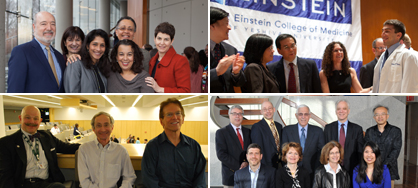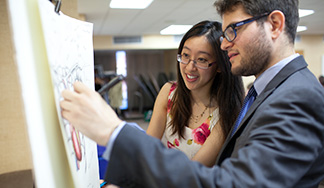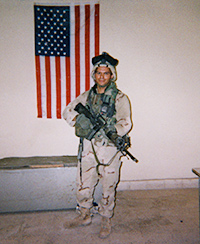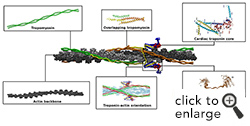

Following His Passions to an M.D.-Ph.D.
Ed Manning: An Unusual Bridge-Builder
The work of physician-scientists can seem daunting–forging a bridge that stretches from the medicine of today to the hope of healing that may be possible tomorrow. For Ed Manning, who graduates with an M.D.-Ph.D. from Einstein this May, the road to that bridge spanned nearly 6,000 miles, from New York to Iraq.

Ed Manning, Class of 2014A former major in the U.S. Marine Corps, Mr. Manning led a rifle platoon during the 2003 invasion of Iraq. Perhaps that's unusual preparation for someone who will soon begin a fellowship in internal medicine and pulmonary critical care at the Hospital of the University of Pennsylvania. But for Mr. Manning, the transition from the Marines to bench and bedside was a natural one.
During high school in Syracuse, NY, he discovered his love of mathematics and science, and went on to earn an undergraduate degree in physics and in Russian from the State University of New York at Albany. After traveling in the former Soviet Union, he joined the Marine Corps in 1995 "out of a sense of obligation," he said.
"I realized I had these freedoms, these rights and privileges that others don't. And as a result, I felt I had to do something for my country."
Applying Science to Real Life
In addition to his combat duty in Iraq, Mr. Manning participated in undersea diving missions and eventually served as a dive medic. The experience combined his love of service and of science, requiring him to work on a daily basis with gas-pressure laws and other principles of physics in order to protect fellow Marines. "For me, the Marine Corps provided the ultimate practical application of science."

Ed Manning during his deployment in IraqBut the military also gave him more. "The military teaches you to plan for every contingency, something that's especially important in medicine," he said. "My experience in the Marines also helped form my thought process. It's not about being rigid. It's about understanding and sharing a common goal, and being able to make decisions with limited information, sometimes with very limited time, in order to achieve that goal."
Combining Bench Science and Clinical Study
Mr. Manning's service eventually led him to earn a master's degree in physics at Hunter College, and then to enter Einstein's Medical Scientist Training Program (MSTP). Continuously funded by the National Institutes of Health since 1964 to offer a combined M.D.-Ph.D. degree, Einstein's MSTP enrolls 12 to 14 first-year students each year through its highly competitive program.
At Einstein, Mr. Manning worked in the lab of Dr. Steven Schwartz, who is currently professor of chemistry and biochemistry and of applied mathematics at the University of Arizona, and also maintains an adjunct appointment as professor of physiology & biophysics at Einstein. One part of his research program examines—at an atomic level—how changes in proteins lead to disease.
Mr. Manning's work took him to another "bridge"—developing a computational model of the link between certain protein mutations and familial hypertrophic cardiomyopathy, an often-deadly disease that affects 1 in 500 people worldwide and is the most common genetic heart disease in the United States. The research is co-directed by Dr. Schwartz and his wife, Dr. Jil Tardiff, an Einstein MSTP alumna who is now professor of cellular and molecular medicine at the University of Arizona and director of its Hypertrophic Cardiomyopathy Clinic.

This is an image of cardiac thin filament, resulting from Mr. Manning's thesis work."Ed worked well in both labs," said Dr. Tardiff. "He was able to bridge both sides, basic science and clinical, because he respected the contribution each is making. And he was relentless in the way he sought answers."
Hard Work, Humility and Compassion
Dr. Schwartz agreed, while crediting his success to another quality: "Ed is incredibly self-motivated," he said. "He has a great ability to take the bull by the horns, to get the hard work done, toward achieving an objective. That's important in research, especially when you're part of a small team."

The various components depicted in this image helped Mr. Manning piece together the puzzle that allowed him to develop... read moreThe model Mr. Manning assisted with developing may someday help predict how mutations in the thin filament of cardiac muscle can affect heart contraction, and ultimately lead to disease. Meanwhile, Mr. Manning's work has already had a clinical impact, according to Dr. Marianne Haughey, associate professor of clinical emergency medicine at Einstein, who worked with him during his first-year "Generalist Mentorship Program" and his trauma tutorial emergency medicine elective during his final year of medical school, both at Jacobi Medical Center.
"Ed brings a sense of compassion, of quiet capability, and humility," she said. "Those qualities are absolutely essential in emergency medicine and are the qualities that mark the best physicians."
Mr. Manning, now 41 and the married father of two young sons, is characteristically humble about his achievements and his future.
"It's been an unusual path. I never thought I'd be where I am today," he said. "I'd like to think I've made some contribution to understanding disease or helping patients. But while I haven't always had answers, I know I've been fortunate to be able to ask questions."
Posted on: Tuesday, May 27, 2014


